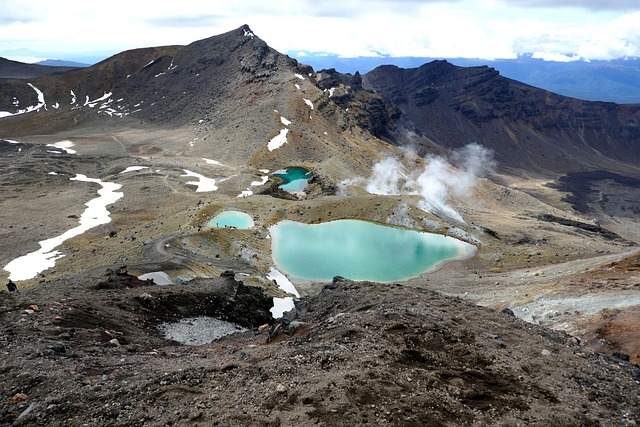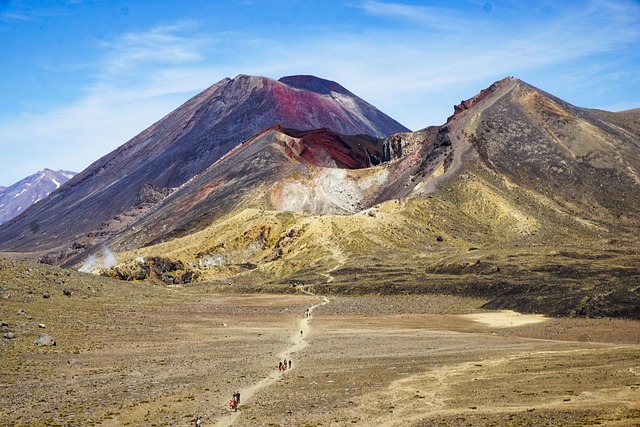The Tongariro Crossing is one of New Zealand’s most iconic hikes, known for its stunning landscapes, unique geological features, and the challenge it poses to hikers.
Whether you’re drawn by the prospect of trekking across volcanic craters, witnessing emerald lakes, or simply enjoying the great outdoors, the Tongariro Crossing offers an unforgettable experience.
However, to ensure your hike is safe and enjoyable, it’s crucial to be well-prepared.
This guide addresses common questions and concerns, providing comprehensive safety tips to help you make the most of your adventure.

Common Questions and Concerns
What Should I Pack?
Packing appropriately is the first step to a safe hike. Here’s a detailed list of essentials and why each item is important:
- Sturdy Hiking Boots: Ensure they are well broken in to avoid blisters. Boots with good ankle support can prevent injuries on uneven terrain.
- Layered Clothing: The weather can change rapidly. Dress in layers to adjust to temperature changes. Start with a moisture-wicking base layer, add an insulating mid-layer (like fleece), and finish with a waterproof and windproof outer layer.
- Sun Protection: Even on cloudy days, UV rays can be strong. Pack sunglasses with UV protection, a wide-brimmed hat, and sunscreen with at least SPF 30.
- Plenty of Water: Staying hydrated is crucial. There are no reliable water sources along the trail, so bring at least 2-3 liters.
- Food: High-energy snacks are essential to keep your energy levels up. Consider trail mix, dried fruit, energy bars, and sandwiches.
- First Aid Kit: Include band-aids, antiseptic wipes, pain relief medication, blister treatment, and any personal medications.
- Map and Compass: While the trail is well-marked, a map and compass are essential for navigation in case of emergencies or poor visibility.
- Emergency Blanket: Compact and lightweight, it can provide warmth if you find yourself in a challenging situation.
- Headlamp or Flashlight: Essential if you’re starting early or think you might be on the trail as it gets dark.
- Extra Layers: Pack an extra pair of socks and gloves in case of cold or wet conditions.
- Trash Bags: Carry out all your trash to help preserve the natural beauty of the area.
Understanding the Weather
The weather in Tongariro National Park is notoriously unpredictable.
Here’s how to prepare:
- Check the Forecast: Always check the weather forecast before you leave. Websites like MetService offer detailed weather updates for the area.
- Prepare for Rapid Changes: Conditions can shift quickly from sunny to stormy. Pack clothing for all weather scenarios.
- Know the Seasonal Patterns:
- Summer (December to February): Generally warmer, but still prone to sudden rain and wind. Mornings can be chilly.
- Autumn (March to May): Cooler temperatures and more stable weather, but early snow is possible.
- Winter (June to August): Cold, snowy, and potentially dangerous. Only attempt the crossing with proper winter gear and experience.
- Spring (September to November): Melting snow can make the trail slippery and treacherous. Weather is highly variable.
Fitness and Preparation
The Tongariro Crossing is a challenging hike, and being physically prepared is crucial:
- Training Regimen: Start with shorter hikes and gradually increase your distance and elevation gain. Focus on building leg strength and cardiovascular endurance.
- Strength and Endurance Exercises: Squats, lunges, and step-ups can build leg strength. Cardio workouts like running, cycling, or swimming improve stamina.
- Pace Yourself: It’s important to hike at a steady, sustainable pace. Listen to your body and take breaks as needed.
- Acclimatization: If you’re not accustomed to higher altitudes, spend a few days hiking at lower elevations before attempting the crossing.
Trail Etiquette and Safety
Respecting the trail and fellow hikers helps ensure everyone’s safety and enjoyment:
- Stay on the Path: This protects the fragile environment and prevents accidents.
- Yield to Faster Hikers: Step aside to let them pass safely.
- Respect Wildlife: Keep your distance and do not feed animals. Pack out all trash.
- Leave No Trace: Follow the principles of Leave No Trace to minimize your impact on the environment.
- Emergency Contact: Inform someone of your plans and estimated return time. Consider carrying a personal locator beacon (PLB) for emergencies.
Personal Stories and Tips
Personal experiences can offer valuable insights. Here are a few stories and tips from fellow hikers:
- Emma’s Experience: “I underestimated the sun’s intensity and ended up with a sunburn despite the cloudy weather. Now, I always pack a high-SPF sunscreen and reapply it frequently.”
- Mark’s Lesson: “Bringing a lightweight, portable charger was a lifesaver. My phone’s battery drained quickly from taking too many photos and using GPS. Having a backup power source kept me connected and safe.”
- Sarah’s Advice: “I started my hike too fast and got exhausted halfway through. It’s better to go slow and steady, especially during the steep sections. Don’t be afraid to take breaks and enjoy the scenery.”
Safety Tips in Detail
Start Early
Starting your hike early in the morning has multiple benefits:
- Avoiding Crowds: The trail is less crowded, making for a more peaceful experience.
- Weather: Morning weather tends to be more stable and cooler, which is ideal for hiking.
- Time Management: Starting early gives you plenty of daylight to complete the hike at a comfortable pace.
Know Your Limits
Understanding and respecting your physical limits is crucial:
- Listen to Your Body: If you feel fatigued or unwell, take a break or consider turning back.
- Hiking with Others: If you’re hiking in a group, make sure everyone is comfortable with the pace and distance.
- Emergency Exits: Familiarize yourself with emergency exit points along the trail in case you need to leave early.
Stay Hydrated and Nourished
Maintaining energy levels is vital for a long hike:
- Hydration: Drink water regularly, even if you don’t feel thirsty. Dehydration can sneak up on you, especially in cooler weather.
- Nutrition: Snack frequently on high-energy foods. Aim to consume a mix of carbohydrates, proteins, and fats.
Be Prepared for Emergencies
Despite the best preparations, emergencies can happen. Here’s how to be ready:
- Emergency Blanket: Lightweight and compact, it can provide critical warmth in an emergency.
- First Aid Skills: Basic first aid knowledge can be invaluable. Consider taking a course before your hike.
- Communication: Mobile phone reception is patchy along the trail. Carrying a personal locator beacon (PLB) can help you get help in remote areas.
Respect the Environment
The Tongariro Crossing is a protected area with unique ecosystems:
- Stay on Marked Trails: This prevents damage to fragile environments and reduces your risk of getting lost.
- Carry Out Trash: Bring a small bag to carry out all your waste. Leave no trace to keep the trail beautiful for others.
- Cultural Respect: The area is of great cultural significance to the Māori people. Respect any signs or guidance regarding culturally sensitive areas.

Weather Awareness
Keeping an eye on the weather is crucial for safety:
- Regular Checks: Check the forecast multiple times before and during your hike. Weather can change rapidly in alpine environments.
- Dress Appropriately: Layer your clothing to adapt to changing conditions. Waterproof and windproof gear is essential.
- Know When to Turn Back: If the weather deteriorates, don’t be afraid to turn back. Your safety is more important than completing the hike.
Navigation Skills
While the trail is well-marked, basic navigation skills are important:
- Map and Compass: Always carry a map and compass, and know how to use them. They can be lifesavers in poor visibility or if you stray from the path.
- Trail Markers: Pay attention to trail markers and signs. They provide important information about the route and conditions.
Physical Preparation
Being in good physical condition will make your hike more enjoyable and safe:
- Training Hikes: Build up your stamina with regular training hikes. Gradually increase the difficulty to match the Tongariro Crossing.
- Strength Training: Exercises like lunges, squats, and step-ups will strengthen your legs and core, essential for handling the trail’s varied terrain.
- Cardio Fitness: Improve your cardiovascular fitness with activities like running, cycling, or swimming. This will help you manage the hike’s physical demands.
Mental Preparation
Hiking the Tongariro Crossing can be mentally challenging:
- Set Realistic Goals: Understand your fitness level and set realistic goals for your hike. It’s okay to take your time and enjoy the journey.
- Positive Mindset: Stay positive and enjoy the experience. The stunning scenery and sense of accomplishment are worth the effort.
Post-Hike Recovery
Taking care of yourself after the hike is just as important:
- Stretching: Spend some time stretching your muscles after the hike to prevent stiffness and soreness.
- Hydration and Nutrition: Rehydrate and eat a nutritious meal to replenish your energy levels.
- Rest: Give your body time to recover. Rest well and avoid strenuous activities for a few days.
Conclusion
Hiking the Tongariro Crossing is an incredible experience that offers breathtaking views and a sense of accomplishment.
However, it’s essential to be well-prepared and mindful of safety.
By following these tips and taking the necessary precautions, you can ensure a safe and enjoyable hike.
Respect the environment, listen to your body, and take the time to soak in the natural beauty around you.
Happy hiking!





